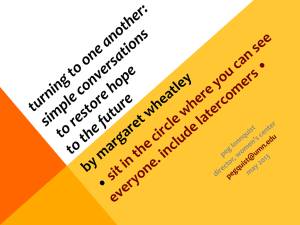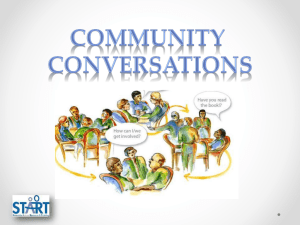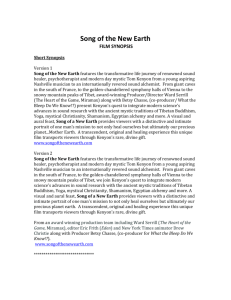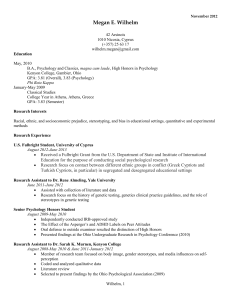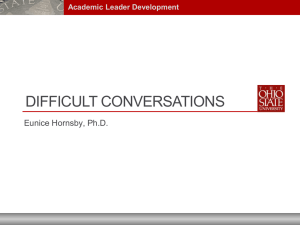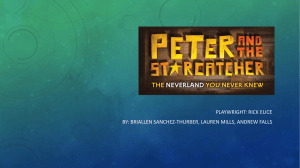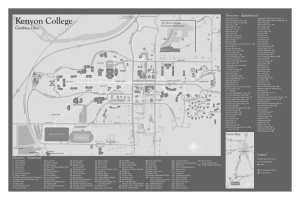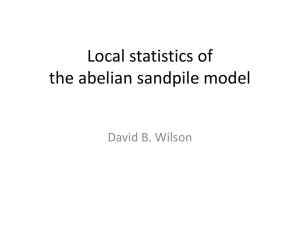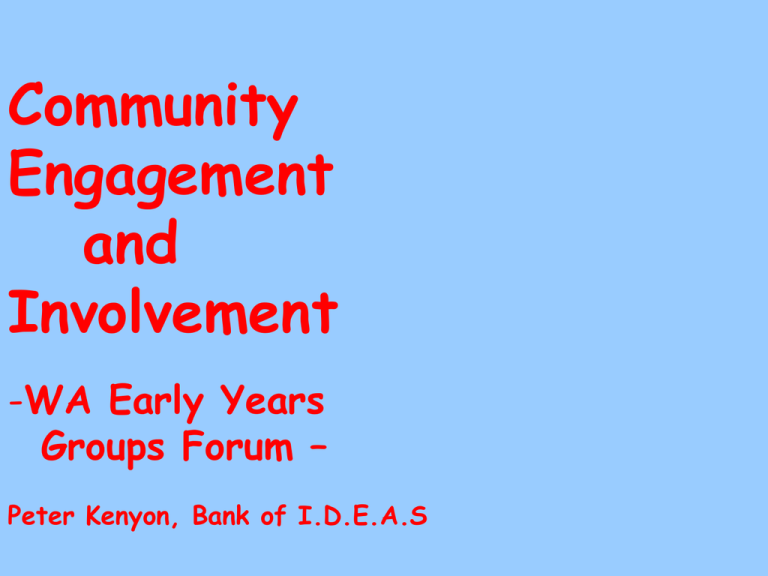
Community
Engagement
and
Involvement
-WA Early Years
Groups Forum –
Peter Kenyon, Bank of I.D.E.A.S
“Leadership and learning
are indispensable from
each other”
(John F Kennedy, prepared for delivery in
Dallas, the day of his assassination, Nov,
1963)
‘It’s what you learn
after you know it
all, that counts.’
(John Wooden)
‘There can be no
keener revelation of a
society’s soul, than the
way it
treats its
children.’
(Nelson Mandela)
‘If you want to go
faster, go alone. If
you want to go
further, go together.’
(African Proverb)
‘It takes a whole
village to raise a
child.’
(African Proverb)
‘It takes a child to
inspire a village.’
(Bliss Browne)
The word 'community' is a broad term
used to define groups of people;
whether they are stakeholders,
interest groups, citizen groups etc. A
community may be a geographic location
(community of place), a community of
similar interest (community of
practice), or a community of affiliation
or identity (such as industry or sporting
club).
(Dept of Sustainability and Environment, Victoria)
‘Engagement' is used as a generic,
inclusive term to describe the broad
range of interactions between people.
It can include a variety of approaches,
such as one-way communication or
information delivery, consultation,
involvement and collaboration in
decision-making, and empowered action
in informal groups or formal
partnerships.
(Dept of Sustainability and Environment, Victoria)
Community engagement can take many forms and
covers a broad range of activities. Some
examples:
Informing the community of policy and program
directions.
Consulting the community as part of a process to
develop policy and program, or build community
awareness and understanding.
Involving the community through a range of mechanisms
to ensure that issues and concerns are understood and
they become part of the decision-making process.
Collaborating with the community by developing
partnerships to formulate options and provide
directions.
Empowering the community to make decisions and to
become part of implementing and managing change.
DRAFT
Resource Kit
For Starting and Sustaining
‘Early Years’ Community Networks
‘Communities working together to
improve outcomes for their
children’
Produced by the Dept for Communities
Key learning 1
Build from the Inside Out
‘I work from the
firm belief that
“whatever
the issue,
community is
the answer.”’
(Margaret Wheatley, Author)
‘Strong communities are created
when residents are the producers
of their own future. They can not
be replaced. No professional,
institution, business or government
can substitute for the power,
creativity or relevance of
productive residents’.
(Mike Green)
‘The more parent and
resident fingerprints that
can be found on a
project, the more likely it
is that project will be
meaningful and
sustainable’.
(Cormac Russell)
‘All the historic evidence indicates
that significant community
development only takes place when
local community people are
committed to investing themselves
and their resources in the effort.
That's why you can't develop
communities from the top down, or
from the outside in’
(John McKnight, Jody Kretzmann)
‘Most communities can often be
compared to a football game
where 30,000 people who need
the exercise, turn up to watch
36 players
who don’t.’
(Peter Kenyon)
‘People support what
they help to create.
They want to make it
happen’.
(Peter Kenyon)
Key learning 2
Move from Inform to Empower
Public Participation Spectrum
Increasing level of public impact
Inform Consult
Involve
Collaborate Empower
Key learning 3
Focus on relationship building
‘Relationship building is
the fundamental action
of community building.’
(Libby Ozinga)
Key learning 4
Discover what people care about
‘There is no
power for
change greater
than a
community
discovering what
it cares about’.
(Margaret Wheatley, Author)
‘People who
care are a
community’s greatest
asset.’
(Paul Born)
‘When people come together
in conversation about what
truly matters to them, they
take ownership and
responsibility for moving their
issues and ideas into wiser
actions that last ’.
(The Art of Hosting)
‘Determination, energy and
courage appear
spontaneously when
we care deeply.
We take risks that
are unimaginative in
any other context’.
(Margaret Wheatley)
Community: a place filled with care
Care remains invisible unless you have
conversations about what people care
about.
People may not care about what you want
them to care about.
Care must be discovered through
relationships.
Learning conversations are the way to
build relationships that make care visible.
(Mike Green)
Key learning 5
Remember the importance of
‘
conversation
Creating a positive change
begins simply with conversation.
It is the way we human beings
have always thought together
and initiated action.’
(Peter Kenyon)
‘The simplest and most powerful
investment any member of a
community or an organisation
may make in terms of
community building is to begin
talking with other people as
though the answers mattered.’
(William Greider)
Key learning 6
Start where people are at
‘Go to the people
Live among them
Learn from them
Love them
Start with what they know
Build on what they have
But of the best leaders when their task is
done
The people will remark
“We have it done it ourselves”’.
(Lao Tze)
Nugal Region
40 schools visited and 16,000 students
addressed;
140 young people involved in dialogues dubbed
‘work towards your dreams’ during half time
breaks in live soccer broadcast venues;
131 young labourers consulted at four
construction sites;
300 girls involved in discussions at three
Burranbur sessions;
180 young scholars gathered in 34 tea houses
near mosques engaged in conversations;
125 young people within IDP’s were
involved in discussions;
48 young people from minority groups were
consulted;
510 young people were engaged in 25 khat
chewer ‘bushes’;
80 milk vendors and delivery boys, and 30
checkpoint guards contributed their
opinions; and finally
25,000 young people tuned into a range of
radio awareness and talkback programmes.
Mudginbadi, Kakadu
It’s all about these guys and their futures
Key learning 7
‘
innovative
Be
in
structuring
conversation and
contribution
Great ExampleTHE FLASH MOB at the
KARRINYUP SHOPPING
CENTRE
http://www.youtube.com/storytellermedia
Key learning 8
Have fun!
‘Why hold a meeting,
when you
can have
a party?’
(Jim Diers, former Director Department
of Neighborhoods, City of Seattle)
Remember that …
‘’Food is to a
community what water
is to fish’
Key learning 9
Don’t preach
‘
concepts, tell
stories
‘The world is not made up of
atoms, it is made up of
stories’
(Peter Kenyon)
‘Story telling is the most
powerful way to put ideas
into the world today’.
(Robert McKee)
Key learning 10
Promote, ‘ promote
and promote
“Without promotion, something
terrible happens…nothing!”
(PT Barnum)
Key learning 11
Recognise,‘ reward
and develop local
residents
‘There are two ‘things people want
more than sex and money …
recognition and praise.’
(Mary Kay Ash)
Key learning 12
Kick some
‘
Goals
‘Nothing breeds success, like
success’ (Annon)
Don’t just
meet to meet,
meet to go
somewhere
-Saul Allinsky
“Effective community
engagement and
involvement ai’nt rocket
science stuff…it’s about
attention to some basics”
Creative tool …Café
Conversations
Café Conversation Ground Rules
•Focus on what matters to you
•Contribute your thinking and those ‘out
of a box’ ideas
•Speak your mind and heart
•Link and connect ideas
•Listen to understand
•Play Doodle Draw
•Have fun!
Discussion Question 1Engaging local community
people- share practical
experiences about what
you have found works.
Discussion 2Share what you have
found builds strong
Network collaboration
Discussion 3Re the future, what needs
to happen to build a
‘Network of Networks’ ?
www.bankofideas.com.au
COPYLEFT POLICY
BOI resources, either in full or part, can be
copied, quoted, reprinted, given away and
circulated. Parts may be torn out,
extracted, summarised and further
enhanced. In short, all the contents are
public property. Please use in any way to
build the passion, skills and knowledge of
citizens to contribute to healthier local
communities and economies.
‘We want so much that our
daughters know a community
life that is truly good....my
dream has always been that
Anne will the get the chance
to live a life where she is
needed for her gifts’ ‘
(Mike Green)
‘I can’t save the world
on my own...it will take
at least three of us’
(Bill Mollison, founder of the
Permaculture Movement)
‘To journey through chaos, we must engage
with one another as explorers and
discoverers. I believe the passage is
possible only if we claim these roles. We
need to realize that no single person or
school of thought has the answer, because
what’s required is far beyond isolated
answers. We need to realize that we must
inquire together to find the new. We need
to turn to one another as our best hope for
inventing and discovering the worlds we are
seeking…’
(Margaret Wheatley)
Contact Details
Peter Kenyon
Email for copy of presentation:
pk@bankofideas.com.au
Website for bookshop & newsletter mailing
list:
www.bankofideas.com.au

